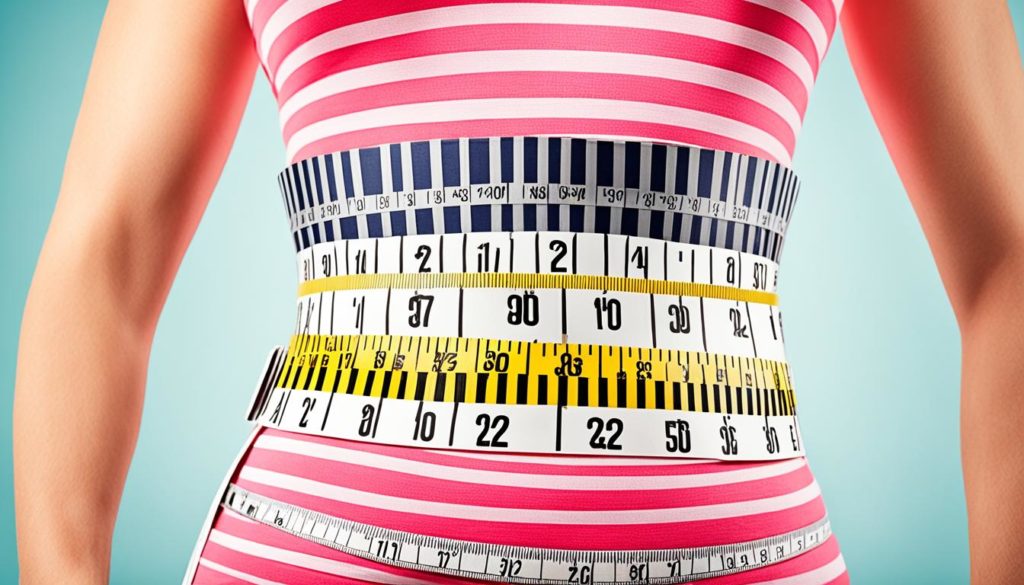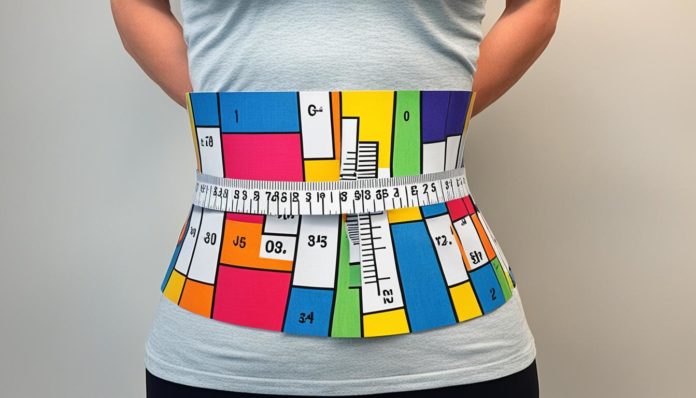Did you know that a waist size over 40 inches for men and 35 inches for women raises the risk of chronic diseases? It’s key to know and keep an eye on your waist size for good health and to avoid obesity issues.
This guide covers the importance of measuring your waist right. You’ll find out what tools you need for accurate measurements. You’ll also learn about the health risks of having too much belly fat and how to read your waist size chart. With more people facing health issues from lifestyle choices, knowing your waist size is a key way to check your health.
Key Takeaways
- Accurate waist circumference calculation is essential for health monitoring.
- Waist measurements can indicate risks of chronic diseases like diabetes and heart disease.
- Proper tools and methodology are crucial for precise measurement.
- An accurate waist size chart helps in interpreting results accurately.
- Abdominal obesity measurement is a key factor in managing overall health.
Why Accurate Waist Circumference Calculation Is Important
Knowing how to measure your waist right is key for good belly health and lowering disease risk. This simple check-up tells a lot about your health. It’s often missed but very important.
Understanding Abdominal Health
Getting your waist size right is crucial for belly health. It shows how much belly fat you have, which is a big health risk factor. By checking your waist size often, you can spot changes early and keep your belly healthy.

Measuring your waist tells you more about your body fat than just your weight or BMI. It points out the dangers of visceral fat, the deep fat around your organs.
Connection to Chronic Diseases
Measuring your waist size is linked to your risk of chronic diseases. Studies show a strong link between a big waist and diseases like type 2 diabetes, heart diseases, and metabolic syndrome.
Big waist sizes mean a higher risk of these diseases. A waist check can show early signs of health changes before they turn into serious diseases.
The following table shows how waist size affects disease risk:
| Men’s Waist Circumference | Women’s Waist Circumference | Chronic Disease Risk |
|---|---|---|
| < 40 inches | < 35 inches | Lower |
| ≥ 40 inches | ≥ 35 inches | Higher |
Watching and managing your waist size helps catch problems early and prevent them. This is why measuring your waist correctly is so important.
Waist Circumference Calculation Method
It’s important to measure your waist size to check your health and lower the risk of chronic diseases. First, gather the tools you need and follow the steps below.
Required Tools
Make sure you have these tools ready:
- Flexible tape measure
- Mirror (optional for better visibility)
- Notepad or health tracking app
Step-by-Step Instructions
Here are the steps to measure your waist correctly:
- Find the top of your hip bone: This spot is just above your belly button.
- Wrap the tape measure: Place the tape at the top of your hip bone and wrap it around your waist.
- Ensure proper fit: The tape should be snug but not too tight. It should be level with the floor.
- Take the measurement: Breathe out normally and measure at the end of your exhale.
- Record the result: Write down your waist size right away, using a notepad or a health app.

| Step | Description | Visual Aid |
|---|---|---|
| 1 | Find the top of your hip bone |
|
| 2 | Wrap the tape measure |
|
| 3 | Ensure proper fit |
|
| 4 | Take the measurement |
|
| 5 | Record the result |
|
By following these steps, you can measure your waist size right. Knowing how to calculate your waist size helps you keep track of your health and lower disease risks.
Best Practices for Measuring Waist Circumference
Getting an accurate waist size measurement is key for tracking your health and spotting risks from belly fat. By following waist circumference best practices, you can make sure your measurements are consistent and correct.
Consistent Measurements
It’s important to be consistent when measuring your waist. Here are some tips to keep your measurements reliable:
- Measure at the same spot on your waist every time.
- Take measurements at the same time of day.
- Stand up straight, breathe out gently, and don’t pull in your stomach.
- Use a flexible, non-stretchable measuring tape for better accuracy.
Avoiding Common Mistakes
To make sure you get an accurate waist size measurement, watch out for these mistakes:
- Incorrect Positioning: Don’t measure too high or too low; find the midpoint between your ribs and hip bones.
- Improper Tension: Make sure the tape is snug but not too tight against your skin.
- Inconsistent Posture: Always stand or sit the same way when measuring.
- Clothing Interference: Measure directly against your skin, not over clothes.
Following these waist circumference best practices will make your measurements more reliable. This gives you useful insights for tracking your health and for professional use.
Using a Waist Measurement Calculator
Using a waist measurement calculator makes tracking your waist size easy and accurate. This tool simplifies complex measurements, giving you trustworthy data every time.
There are many waist circumference tool options online. They offer quick and precise results. These tools are great for those who want to easily understand their health without manual measurements.
Here is a comparative analysis of some reputable waist measurement calculators:
| Online Tool | Features | Usability |
|---|---|---|
| MyFitnessPal | Integrated health tracking, user-friendly interface | High |
| NIH Waist Circumference Tool | Evidence-based recommendations, no registration required | Medium |
| Healthline Calculator | Detailed results, additional health tips | High |
Adding a waist measurement calculator to your health routine is easy. It saves time and reduces errors from manual measurements. This ensures your health data is accurate and consistent.
Interpreting Waist Circumference Results
After getting your waist circumference measurements, it’s key to understand what they mean. Knowing where you fit on a waist size chart gives you important health indicators. These can help guide your health journey.
When interpreting, compare your measurements to the standard guidelines for men and women. These guidelines show health risks and suggest lifestyle changes. Here’s a detailed comparison:
| Gender | Low Risk | Moderate Risk | High Risk |
|---|---|---|---|
| Men | Less than 37 inches | 37 – 40 inches | More than 40 inches |
| Women | Less than 31.5 inches | 31.5 – 34.6 inches | More than 34.6 inches |
If your waist measurement is in the moderate or high-risk range, it’s time to think about making changes. Tools like a waist size chart and health indicators can help you see your health status clearly. Knowing your measurements is the first step to better health.
Waist Circumference Guidelines
Following waist circumference guidelines is key for staying healthy. The World Health Organization (WHO) and the National Institutes of Health (NIH) set limits. These limits help check health risks from abdominal obesity.
Recommended Limits
The guidelines suggest the ideal waist size is about 35 inches for women and 40 inches for men. But, these can change based on your height, ethnicity, and other factors. Here’s a simple guide:
| Gender | Healthy Waist Circumference |
|---|---|
| Women | 35 inches or less |
| Men | 40 inches or less |
Health Implications
Being over these waist size limits means a higher risk of serious health issues. Abdominal obesity is linked to heart disease, diabetes, and metabolic disorders. It’s crucial to follow abdominal obesity guidelines to prevent these diseases.
In summary, checking your waist size regularly and knowing the limits is key to good health. By measuring your waist as the guidelines suggest, you can spot health issues early. This helps in taking steps to stay healthy.
Waist Circumference and Abdominal Obesity
Understanding waist circumference is key to spotting abdominal obesity. It’s a top way to measure central obesity. This method is vital for health checks.
Waist circumference is linked to the waist-to-hip ratio. Together, they show where body fat is stored. To really understand abdominal obesity, use both waist circumference and waist-to-hip ratio. This combo helps see the risks of too much belly fat.
Studies reveal that big waist sizes mean more than just extra fat around the belly. They also point to a higher chance of health problems. These issues include heart diseases, metabolic syndromes, and type 2 diabetes. By looking at waist size and waist-to-hip ratio, doctors can spot those at risk. They can then suggest the right steps to take.
Integrating Waist Measurement with Overall Health Assessments
To understand someone’s health fully, it’s key to use waist measurement with other health checks. This mix of waist measurement, BMI, and body fat percentage shows a full picture of health. It helps make smarter health choices and improve lifestyle habits.
Combining with BMI
Body Mass Index (BMI) helps check how your weight matches your height. But, it doesn’t tell everything about your health, especially about fat distribution. Adding waist measurement to BMI helps doctors see the difference between muscle weight and fat weight. This gives a clearer view of health risks tied to body fat.
“Using both BMI and waist circumference measures can better identify individuals at higher risk of chronic conditions.” – CDC
Additional Assessments
Checking body fat percentage, blood pressure, and cholesterol levels gives a full health picture. Waist measurement is key because it shows belly fat, which is a big sign of metabolic health. When you add waist measurement to these checks, you get a full view of health. This helps make better health plans.
| Assessment Type | Metrics Evaluated | Significance |
|---|---|---|
| BMI | Weight, Height | General body mass evaluation |
| Waist Measurement | Waist Circumference | Abdominal fat indication |
| Body Fat Percentage | Fat Mass, Lean Mass | Overall fat distribution |
| Blood Pressure | Systolic, Diastolic pressure | Cardiovascular health indicator |
| Cholesterol Levels | HDL, LDL, Total Cholesterol | Lipid profile assessment |
By mixing waist measurement with BMI and other health checks, people and doctors get a clear, detailed look at health. This leads to more focused health care plans.
Conclusion
As we conclude this guide on waist circumference measurement, it’s clear that measuring your waist accurately is key to staying healthy. By using the methods and tips shared, you can make sure your measurements are correct. This is important for spotting health risks early.
Studies show that your waist size can tell a lot about your health risks. These risks include heart problems, death, diabetes, and metabolic issues. Adding waist measurement to your health routine can really help. It works well with other health checks like waist-to-height ratio and BMI to give a full view of your health.
So, waist circumference is more than just a number; it’s a key health indicator. By making waist measurements a part of your health care, you can make better health choices. This shows how vital accurate waist measurements are for checking your health. We hope these tips and advice help you on your path to better health.
FAQ
What tools do I need for accurate waist circumference calculation?
You’ll need a flexible tape measure, like cloth or plastic. Make sure it fits comfortably around your waist.
Why is waist circumference calculation important?
Measuring your waist helps spot abdominal obesity and health risks. These risks include type 2 diabetes, heart disease, and metabolic syndrome.
How do I calculate my waist circumference?
Stand up straight and wrap the tape measure around your waist. It should be at the midpoint between your rib cage and hip bones. The tape should be snug but not too tight. Take the measurement after you’ve breathed out.
What are the best practices for measuring waist circumference?
Measure at the same time every day, under the same conditions. Don’t make mistakes like pulling the tape too tight or measuring over clothes. Keep the tape level.
How can a waist measurement calculator help me?
A waist measurement calculator makes it easy to get accurate results. It considers more factors to give you a full health assessment.
How do I interpret my waist circumference results?
Use a waist size chart to compare your measurements. A waist over 40 inches for men or 35 inches for women may mean health risks. Always check guidelines for your gender and age for the best interpretation.
What are the recommended waist circumference limits?
The WHO and NIH suggest men aim for a waist under 40 inches and women under 35 inches. This helps avoid health risks from abdominal obesity.
How does waist circumference relate to abdominal obesity?
Waist circumference is a key measure for abdominal obesity. It directly assesses visceral fat, which is more dangerous than subcutaneous fat. Higher values mean a higher risk of obesity-related problems.
Can I combine waist circumference with BMI for better health assessment?
Yes, using waist circumference and BMI together gives a fuller picture of your health. BMI shows overall body fat, while waist circumference focuses on abdominal fat. This combination helps assess metabolic and cardiovascular risks better.
What should I do if my waist circumference exceeds recommended limits?
If your waist is over the recommended limits, talk to a healthcare professional. They can help you with lifestyle changes, diet, and exercise to reduce belly fat and improve your health.


